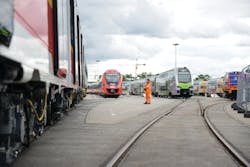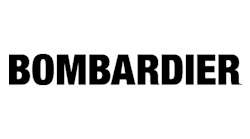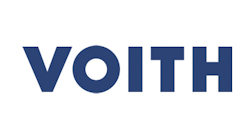InnoTrans has become an international platform for buyers and sellers of rail transport technology. Located at Messe Berlin in Berlin, Germany, it features a full range of rail vehicles presented on display on tracks located outside the exhibition halls.
The exhibition space consist of 26 halls covering 160,000 square meters (1.75 million square feet) and outside is nearly 2 miles of display track. This year InnoTrans saw 106,000 visitors from more than 100 countries.
Messe Berlin Director Matthias Steckmann and Project Manager Kerstin Schulz are responsible for putting on InnoTrans. Steckmann says there are a couple of exhibitions at Messe Berlin that utilize the entire fairgrounds and this year was the first time InnoTrans used that whole space.
Steckmann and Schulz explain that for InnoTrans, the focus is on the exhibition as a marketing platform but they also support the convention with short, concentrated panel discussions. “It's very important for us to keep this focus and to differentiate from other event like congresses with participating exhibitions,” explains Steckmann. “We are not a conference or a Congress; we are a marketing platform first of all.”
Despite the economy, InnoTrans saw an increase in exhibitors and visitors. “We have an all-time high this year,” Steckmann says. “We have 2515 exhibitors participating from 49 countries. Compared to InnoTrans 2010, it’s an increase of around 11 percent and that’s why we now use all the space.”
Szhulz says, “I think there are counties that are not well right now; these countries don’t avoid InnoTrans.” She continues, “They come to InnoTrans especially because they know they cannot stay away … because if they don’t, they don’t do business.
She says, “So that’s why they invest. There’s the whole world and they make business here.”
The United States had a booth in the pavilion and Schulz says next year, they plan on coming individually. “First you have to come and look at how big it is; how many visitors and high-quality visitors. They realized next time they come on their own.”
Steckmann stresses that the reach of the show is international. The number of non-European countries is steadily increasing. This past year, Japan had its own hall and there were 13 companies from the Arab region for the first time.
Planning for 2014
“We already know what the future will bring because we already have mountains of applications for next time for exhibitors,” Steckmann says. “We don’t have space.” He adds, “It’s a nice problem to have.”
Schulz explains that they have already had limited space this year and for their Oktoberfest, there was limited space to build the restaurant inside of a hall. “So we put the restaurant outside.” With creative solutions they’ve come up with before, they aren’t concerned with accommodating the show’s growth.
Alcatel-Lucent
Solutions and innovations which enable rail transport to stay on the track were showcased by Alcatel-Lucent, including its Railways Telephony Solution, Management Platform (ICMS), LTE-4G networks for ground-train communications, proactive maintenance and mobile applications for technicians, and InfoGate, its video and multimedia information kiosk for passengers.
InfoGate offers customers a personal service. A press of the button at the InfoGate counter puts passengers in contact with an agent who can offer them advice. This agent appears in the form of a high-definition image on the screen of the multimedia kiosk, and can answer questions just as if he were present on the platform. This service can be provided in several languages.
In addition to reproducing images and sound, the InfoGate counter also offers many other interactive possibilities, such as an NFC interface, a quick-response code reader for transferring data to and from a smartphone, a high-definition camera for scanning any rail tickets which the agent needs to change and a printer to print out the new ticket.
The counter is connected to a multimedia contact center via a wireless broadband network.
Voith
Voith showcased products and installations around the motto “Experience How You Get Ahead!” Included were the new vehicle head concept Galea and Voith SteamTrac, a waste heat recovery system.
The Galea rail heads, made from fiber composite materials, are collision-safe. They stand for maximum safety and, apart from meeting all requirements on collision protection, also comply with the latest fire protection, anti-noise and heat insulation standards. As front ends are subject to extreme loads during accidents, special structural and energy absorption elements are being used.
Vehicle heads of the Galea series are suitable for trains with speeds of maximum 124 miles per hour.
Waste heat from the engine that used to remain unused is converted into additional drive energy for the vehicle via a piston expander with SteamTrac. This results in higher outputs, while fuel consumption and thus CO2 emissions are reduced.
The SteamTrac system can be used for all combustion engines. The first rail vehicle with a SteamTrac is in service on the Kaiserstuhl Railway in Baden-Württemberg.
With the SteamDrive system, mechanical energy gained by the Voith SteamTrac is fed to a generator. The function principle is identical; the only difference: electrical energy is generated rather than mechanical energy. This energy can be used for the on-board power system — and reduces both fuel consumption and emissions of the on-board generators.
Bombardier Transportation
Bombardier highlighted 20 innovations, including the Bombardier Flexity 2 low-floor tram, Bombardier Traxx F140 AC locomotive, Traxx P160 DE Multi-Engine, as well as the emission-free Bombardier Primove e-mobility solution for all types of electric vehicles. Also shown were the Bombardier Mitrac permanent magnet motors and examples of how Bombardier is enhancing passengers’ high-speed journey, including a full-scale mock-up of the V300ZEFIRO very-high-speed train for Italy with its next generation Bombardier Flexx Speed bogies.
The Flexx bogies reflect the requirements of intercity and high-speed trains by comprising a high-comfort suspension system for superior riding qualities. This is taken into consideration by bogie design parameters, such as minimum weight and wear, as well as specific features, such as condition monitoring.
Scheidt & Bachmann
Scheidt & Bachmann showcased modern ticketing solutions and fare collection products. Under the banner “Check-in to the FareGo World of Ticketing” it introduced a complete eTicketing system featuring the entire lifecycle of a smartcard — beginning with personalized card creation at the customer service center, followed by check-in/check-out at the station and top-up in-vehicle, with generation of reports in the back-office system.
Schedit & Bachmann also introduced new mobile applications, which facilitate the work of the service technicians. These allow a comprehensive and ongoing overview of the whole fare collection system — stations, single devices and their modules can be monitored. Performing service work via mobile devices such as tablets and smartphones was also showcased.
The newly developed Multi Application Reader was presented for the first time. The smartcard reader processes contactless media using ISO 14443 A/B for both ticketing and open payment. It allows the parallel usage of different smartcard specifications within a system and manages national specifications, as well as customer-specific formats.






